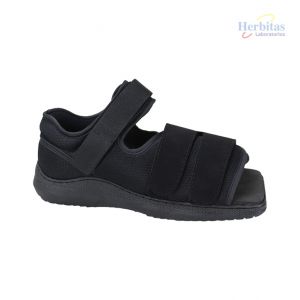Diabetic foot shoes
What are the options for diabetic foot shoes?
There are various options for diabetic foot shoes that help to reduce and redistribute pressures on the foot, promoting the prevention of ulcers and other complications. This type of shoe is essential for protecting the feet of people with diabetes, providing comfort and safety.
What characteristics should diabetic foot shoes have?
Diabetic foot shoes must meet certain specifications to ensure the protection and comfort of the feet. Among the most important characteristics are:
- Soft and non-slip sole: Provides stability and reduces the risk of falls.
- Rocker-shaped toe: Facilitates the lift-off of the forefoot during walking.
- High vamp: Allows the toes to be accommodated without causing friction.
- Low and wide heel: Ideally between 2-4 cm high for greater stability.
- Semi-rigid counter: Offers support to the heel without causing pressure points.
- Fastening system: Laces or velcro that allow proper adjustment.
- No internal seams: Prevents injuries from friction.
How to choose the right shoes for diabetic feet?
Choosing the right shoes for diabetic feet involves considering several factors:
- Comfort: The shoes should feel comfortable from the first use, without needing to "break in".
- Enough space for the toes: There should be enough space in the toe box to avoid pressure on the toes.
- Breathability: Materials such as leather allow the foot to "breathe", reducing moisture buildup.
- Progressive use: New shoes should be worn initially for a few hours a day to avoid blisters.
- Daily inspection: Check the inside of the shoes to ensure there are no objects that could cause harm.
What benefits do post-surgical shoes offer for diabetic feet?
Post-surgical shoes are essential during the recovery from a diabetic foot injury. This type of shoe is designed to offer specific offloading depending on the location of the injury. Characteristics of post-surgical shoes:
- Protection: Helps protect the foot during recovery.
- Ample space and adjustment: Provides enough space to accommodate additional offloading materials like felt.
- Specific offloading: Variants with anterior, posterior, or rocker sole offloading, depending on the injury's needs.
- Stability: Ensures patient stability, often complemented by the use of crutches or walkers.
Why buy diabetic foot shoes?
Diabetic foot shoes are an investment in health and prevention. This type of shoe is specifically designed to provide the necessary support and protection to prevent serious complications such as ulcers and infections. Choosing the right shoes can make a big difference in the quality of life for a person with diabetes, ensuring that their feet are always well cared for and protected.


